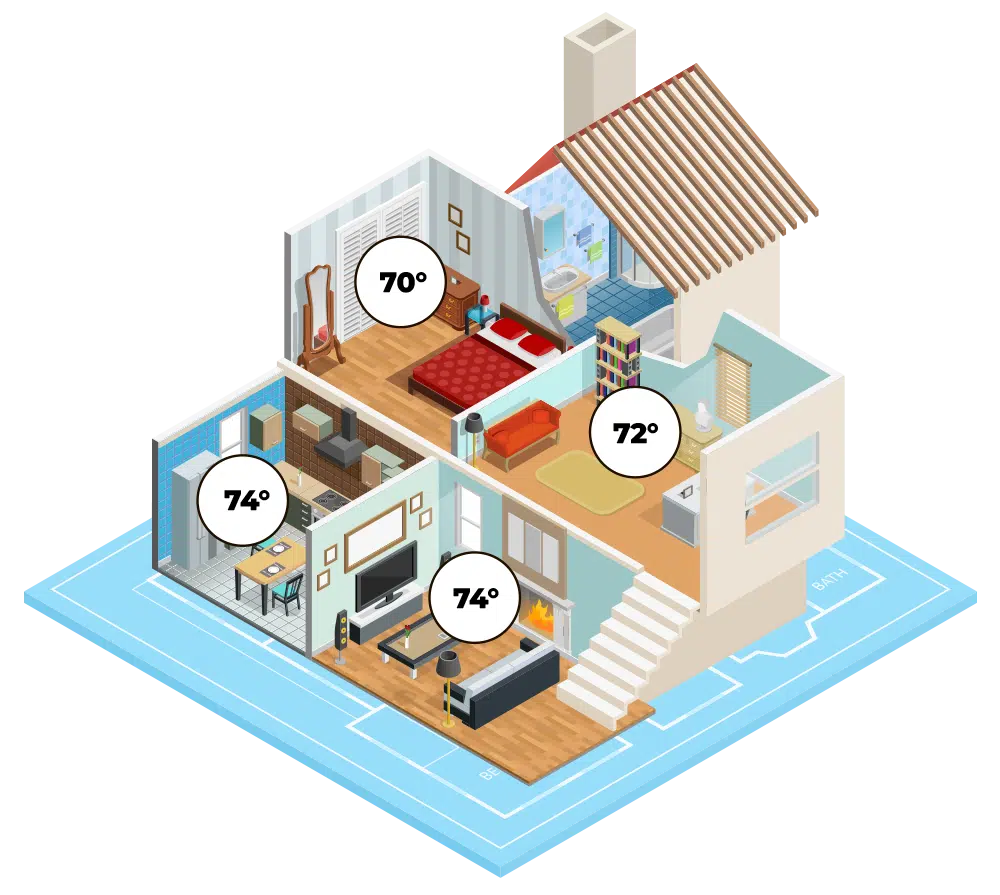You use your kitchen multiple times daily, but that half-painted spare bedroom hasn’t seen a soul in months. So, what do they have in common? You’re paying to heat and cool them both!
Homeowners are always looking to maximize energy efficiency, and HVAC zoning systems offer a compelling solution. These systems allow different areas of your home, or “zones,” to be heated or cooled independently.
While HVAC zoning systems come with numerous advantages, they also have some drawbacks that homeowners should consider. This article explores the pros and cons of HVAC zoning systems and can help you decide if they’re right for your home.

How do HVAC Zoning Systems work?
Zoning systems utilize motorized dampers to control airflow to each “zone.” Each zone has its own thermostat, which opens and closes the dampers based on the temperature setting.
Homes with zoning systems have a central control panel that coordinates the thermostats and dampers to deliver the right amount of conditioned air to the preferred zones.
The Pros of HVAC Zoning Systems
1. Enhanced Comfort
Whether it’s fancy clothes or an HVAC system, there’s just something about having things tailored to your specific preferences. Because you can customize the climate settings of each zone, one of the primary benefits of an HVAC zoning system is the enhanced comfort it provides. As a bonus, it can help your family avoid potential disputes about the ideal temperature.
2. Increased Energy Efficiency
Although it may require a substantial installation cost, zoning can significantly improve energy efficiency and potentially lead to savings in the long run. You won’t pay to heat or cool rooms that you don’t use, meaning your overall energy use will drop. This targeted approach not only leads to lower utility bills but also reduces your home’s carbon footprint.
3. Prolonged HVAC System Lifespan
Since zoning systems reduce the workload on your HVAC system by only conditioning specific areas as needed, they can help extend the lifespan of your HVAC equipment.
4. Improved Control and Flexibility
Modern HVAC zoning systems often have advanced thermostats and control systems that allow precise adjustments. Some even offer smart home integration, enabling you to control the temperature of each zone remotely via smartphone apps or home automation systems.
5. Customization for Different Areas
Different areas of your home have different heating and cooling needs. For example, a kitchen may require less heating in winter due to appliance heat, while a basement might need more. In addition, some homeowners may wish to keep bedrooms on the cooler side while keeping the family room or other lounge areas at a slightly warmer temperature.
The Cons of HVAC Zoning Systems
1. Higher Initial Cost
Installing an HVAC zoning system, whether in a new home build or as an upgrade to your existing system, isn’t cheap. Because it requires additional components such as multiple thermostats, dampers, and a more complex ductwork design, expenses can add up quickly, which may be a barrier for some homeowners.
2. Complex Installation Process
As you might expect, installing a zoning system can be complex, depending on the home’s existing setup. The ease with which you can add zoning to current ductwork is based on several variables that you may or may not be aware of beforehand. The home evaluation and design process can take more time than a traditional system, and it requires a skilled technician with specialized experience.
3. Potential for Maintenance Issues
Edward Aloysius Murphy Jr. gave us the saying, “Anything that can go wrong will go wrong.” When it comes to mechanical systems, whether it’s a car, refrigerator, or HVAC system, the unfortunate reality is that nearly all components will eventually need some maintenance. Whether it’s routine TLC or an extensive repair can come down to several factors – some that are in your control, and some that aren’t.
With more components comes the potential for more maintenance issues. Dampers and additional thermostats may need regular checking and occasional repairs, leading to higher maintenance costs over the system’s lifespan.
4. Compatibility Issues
The first step in upgrading your current system by adding zoning capabilities is making sure it’s feasible. Older homes with outdated or poorly designed ductwork may not be compatible with zoning systems without significant modifications. Additionally, some HVAC systems may not support zoning, requiring a complete system upgrade.
Whole-Home Comfort Starts at Hoock’s
Everyone deserves to feel comfortable in their own home. At Hoock’s Heating and Cooling, our experts help you understand all your options and choose the best option for your home, budget, and unique HVAC needs.
Customers throughout the Greater St. Louis area trust our team because of our commitment to personalized service, no matter the size of the job. Whether you’re considering upgrading your system, need a repair, or simply want routine maintenance that extends the life of your existing HVAC unit, contact Hoock’s today.